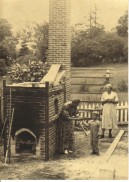Following the Brick Path

|
| The Rowantrees Sign on Union Street |
In the little town of Blue Hill, Maine, a couple of blocks north of the business section and up the hill on Union Street sits a wonderful old two-story Victorian era house, complete with a big porch looking out over Blue Hill Bay. The house entrance on Union Street has a small sign, a picket fence and a gate. Once inside the gate, the visitor is advised to ‘follow the brick path”, and while the brick path has been covered over with a raised deck of weatherproof planking, it none-the-less leads to a series of attached undistinguished shed-like outbuildings. This is the home of Rowantrees Pottery. It has always been housed in these humble wooden outbuildings, constructed (sometimes even hauled to the site) as needed at varying times, on the grounds of the founder’s summer residence. Once inside the buildings, it is apparent that one has entered into a very special place, and indeed, these building hold one of the town’s treasures. Within the spacious sales room (now rather bare) there are photographs and shelves filled with historical pieces of pottery hinting at a rich narrative of the past accomplishments of the pottery.
This book conveys the rich human history of Rowantrees Pottery. Producing outstanding wares, the pottery was beloved by many collectors for the 75 years of its existence. However the pottery was never just a commercial enterprise, it was also a successful embodiment of the American Arts and Crafts Movement, now largely extinct. But that social philosophy governed the production of pottery that was both used and prized by thousands of people - including the family of one President of the United States.
Rowantrees survived because of the personal commitment (and sacrifices) of each of three women; Adelaide Pearson the founder, Laura Paddock, her surviving partner and the person who provided the initial knowledge of pottery, and finally Sheila Babson Varnum, a survivor herself of a terrible childhood illness. Varnum worked at the pottery for more than 30 years before assuming ownership in the mid 1970’s. She continued to operate the pottery until it closed. (A limited edition is available. Limited to 50 copies; casebound, individually signed and numbered is $90 inc s/h.)




